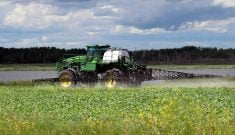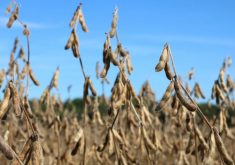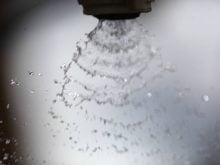Flea beetles and grasshoppers topped provincial entomologist John Gavloski’s list as the peskiest insects on Manitoba farms this past season and he said producers should be on the lookout for them next year.
In addition, “we’ve got three aphid species this year along with your army worms, lygus and cutworms, but our biggest surprise of the year was crickets in field crops,” he said.
Perhaps the biggest factor was the long, cool spring that delayed planting. Seedling crops, especially canola, took a while to develop and matured later in the summer, putting the whole system out of phase.
Read Also

Finally getting paid for sustainable farming?
Alberta project says they might have a line on a workable ecosystem credit model to reward farmers for sustainability, and Manitoba might be next
Emerging canola is susceptible to flea beetles until plants are large enough to shake off the damage.
“So the challenge with flea beetles is to get that plant to the three- to four-leaf stage within four weeks after seeding,” Gavloski said. “We got conditions that kept the plants in that seedling stage for way too long. Seed treatments ran out so people were doing foliar sprays. Sometimes multiple foliar sprays.”
Manitoba has had flea beetle populations at a chronically high level for several years.
“[Flea beetle] seem to overwinter well under our Prairie conditions and we don’t have the natural enemies that seem to knock a population out, the way it does to other insects,” Gavloski said. “So expect them.”
Grasshoppers were the other major pest. In 2021, Manitoba saw a lot of clear-winged grasshoppers but this past summer the two-striped species was more numerous.
“Your clear-winged is your grass specialist. It likes grassy plants and won’t feed on things like canola, soybean and sunflowers,” Gavloski said. “The two-striped is a generalist so if it’s hungry enough, it will feed on just about anything.”
The two-striped is also a big grasshopper with a big appetite. In some fields, spraying the edges can be effective. If the population is heavily concentrated and moving in from a certain ditch or field edge, it may not be necessary to spray the whole field.
“There was some of that edge spraying but there was also whole field spraying that had to be done,” Gavloski said. “We had reports of grasshopper issues from all our agricultural regions. It was quite a widespread thing.”
There was a sharp increase in bee flies and blister beetles. The larvae of both insects are specialists that feed on grasshopper eggs. Crickets are also enthusiastic grasshopper egg eaters and there were quite a few this year.
“They’re omnivores and they eat a lot of things,” Gavloski noted. “But if they come across a batch of grasshopper eggs, that’s great protein and they will definitely feed on it.”
The odd spring and late seeding led to late season problems with a few different varieties of aphids. One was the cereal aphid, which is usually not a problem once cereals reach the soft dough stage.
“This year, because of the early wet weather and the late seeding, we had people spraying for aphids in early August in the cereals,” Gavloski said. “So that was one of the unfortunate consequences of having all the late seeding that we had.”
There were also problems with soybean aphid and an unusual aphid infestation on sunflower.
“There is a species called the sunflower aphid,” Gavloski said. “We don’t often get huge levels. We do see it, but it’s just a one in maybe 10 to 15 year phenomenon when we get these really big populations of it.”
Nature responded to this year’s aphids with large populations of hover flies. They lay their eggs near aphids and their blind, almost slug-like larvae feed on them. The population of Aphidus wasps, whose larvae parasitize aphids, also increased.
Lygus bugs were a regional issue this year and there was some spraying in canola. Gavloski suggested that farmers look at new economic threshold guidelines for spraying lygus.
Manitoba farmers also saw armyworm, a migratory species that’s usually a problem further east. This year they were a problem in some eastern and central regions.
Cutworm populations were down and there were sightings of black army cutworm, a gregarious species that gathers in larger numbers on a single plant. They are unusual for Manitoba.
The big surprise of the year was crickets. Gavloski said they damaged field crops, which is also unusual. Ordinarily, crickets may climb stems and sip morning moisture off the heads but last season they bit into seeds.
“My speculation, and this is just speculation, is that we had high levels of crickets and we had late seeded crops,” he said. “The crops were still mature and juicy enough that when the crickets were abundant and thirsty late in the season, they were going for moisture with these later crops. But it’s really hard to know.”

![“[Flea beetle] seem to overwinter well under our Prairie conditions and we don’t have the natural enemies that seem to knock a population out, the way it does to other insects.” – John Gavloski.](https://static.manitobacooperator.ca/wp-content/uploads/2023/02/09102252/Flea-beetles_Brent-Schram_cmyk.jpeg)













